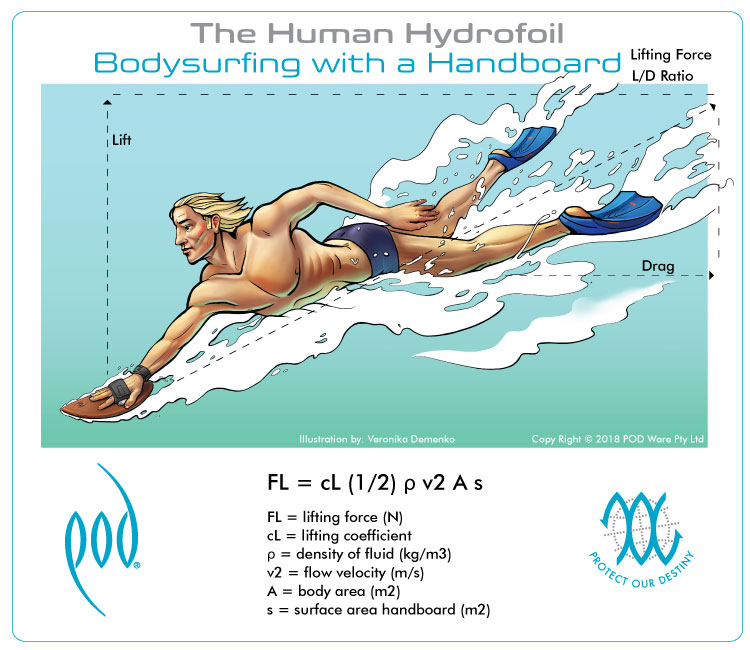
The above physics and graphics of a human hydrofoil or a body surfer.
What is the correct size bodysurfing handboard that will best suit the individual?
Many have questioned this theory; there isn't a right-size handboard?
My answer, in short, is incorrect; why?
Bodyboarders and Surfers Know What's Best
Surfers choose a surfboard's length and volume based on height and weight. Fundamentally, it's no different for a bodyboarder who knows precisely what length, width, rails, thickness, and materials will provide the best performance.
As a Result, It's No Different for a Bodysurfer!
With 35 years of handboard manufacturing and bodysurfing experience, I've thoroughly investigated the best size of handboard surface area and shapes for handboarding.
The right size handboard, which should be just over the size of your hand or up to a maximum of two-half times the length of your hand and up to one-and-half times the width of your hand, is crucial for a body surfer's height and weight.
For example, my height is 170cm, and my weight of 70kgs, plus bodysurfing friends who are 180cm and between 80 - 90kgs ride bodysurfing handboards twice the length and width of their hand; this size provides excellent lifting force, speed and control in the proper surf and wave conditions, with only their handboard and from the lower part of their legs and bodysurfing fins gliding across the wave.
Convex Deck and Concave Bottom Handboard
Before buying the right size handboard, it is essential to have a convex deck and concave bottom for the following reasons.
- Convex equals Comfort in the palm of your hand.
- Concave equals Optimum Lift, Speed, and Control in the surf.
Neutral Buoyancy Handboard
When considering a bodysurfing handboard, its buoyancy is a crucial aspect to focus on. A Neutral Buoyancy Body Surfing Handboard allows for a natural swimming experience, making navigating through the water more comfortable and effortless without adding extra strain on your shoulders.
Overly buoyant handboards can make it difficult to cut into the water effectively. They can also increase the load on your hand, wrist, arm, and shoulder, resulting in a twist of your body to one side.
The size of the handboard significantly influences its performance. A smaller handboard provides less lift, while a larger one offers more significant lift, reducing drag and increasing speed. However, it's crucial to consider what is practical and functional for swimming in the ocean.
Choosing a bodysurfing handboard appropriate for your height and weight is essential for optimal performance. A handboard with a surface area that is too small may not provide sufficient lift and speed for effective bodysurfing, while one that is too large can hinder your ability to swim and catch waves.
This raises the question: How can someone bodysurf with a handboard over three times the length and width of their hand and thicker than 40mm to 50mm? Such boards are often larger than swim kickboards or training boards; some can be as big as skimboards or small bodyboards.
Even for beginner bodysurfers, swimming with an oversized handboard is impractical. Imagine trying to swim freestyle while battling through water with such a cumbersome apparatus. It could quickly become frustrating, causing even experienced swimmers to struggle.
Alternatively, one could use these larger boards by kicking them like a swim kickboard or training board, but this approach is only suitable for minimal surf conditions. Additionally, relying solely on your legs to return to breaking waves limits your swimming capabilities.
There are also public safety concerns associated with using oversized boards, such as sprained wrists and shoulder injuries, as well as the risk of being hit in the face, leading to broken noses, split lips, chipped teeth, or even more severe injuries.
This raises questions about the responsibility of manufacturers who produce such oversized boards, considering the potential harm they could cause to users and those nearby in the surf. Unsurprisingly, bodyboard leashes are often sold as a safety measure.
In summary, oversized boards are impractical and lack innovation and functionality for the bodysurfing community.
Before You Buy a Bodysurfing Handboard
Before you decide to purchase a handboard, it's essential to research the vast array of handplane brands currently available.
Also, find the size best suits your height and body weight so you can easily swim to the break and catch waves naturally.
Remember, the surface area, convexity, and concavity of a handboard are your number one priority in providing you with optimum Comfort, Lift, Speed, and Control.
Another worthwhile read, “Choosing the right pair of bodysurfing swim fins”.